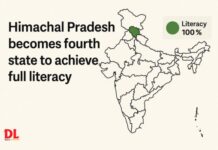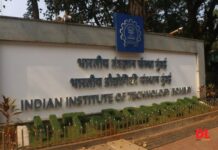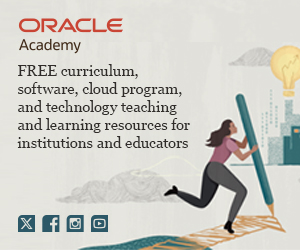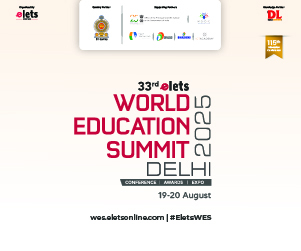BITS is synonymous with quality technical education in the country. It has many firsts to its credit, be it integrationof technology in its examination system, strong industry-academia linkage, or innovation in academics to suit
 the global technological advances. BITS provides three-tiered education in the fields of engineering, technology, economics, management, and pharmacy with an aim to leverage critical manpower gaps across industries. Digital Learning caught up with BITS Pilani Vice Chancellor Prof L K Maheshwari to discuss what makes BITS stand out in the field of technical education.
the global technological advances. BITS provides three-tiered education in the fields of engineering, technology, economics, management, and pharmacy with an aim to leverage critical manpower gaps across industries. Digital Learning caught up with BITS Pilani Vice Chancellor Prof L K Maheshwari to discuss what makes BITS stand out in the field of technical education.
What position does technical education occupy in India’s higher education sector?
There is a great need for technical education in a country like India, especially as far as trained manpower is concerned. The role of technical eduction is to create an integrated personality who not only has a good grasp of his/her subject but is also equipped with ommunication skills, computer skills, inter-personal skills, management skills, etc. These skills are of utmost importance in this era of globalisation, particularly in dealing with cultures of other countries. What is important is to have a broad-based curriculum in technical education, integrating science, engineering, and technology skills. This will place eople from these vocations in greater demand. This is what the experience of BITS has shown. e have been practising this over the last 35 years and you can find BITS alumni every where in the world.
What ICT initiatives have been taken by BITS Pilani in rendering an effective teaching-learning atmsophere?
BITS has the reputation of pioneering the online examinations for admissions through the path breaking integration of BITSAT. In this process, over a lakh students take the admission
test, which is available over a period of 35 days. Under BITSAT, students have the freedom to chose the city, day and even the time of test in the online mode. The scores obtained in each segment is made available instantly at the end of each session. Unlike other institutions like IIT’s, even the counselling of our students efore admission is done online at our campuses. All he information is ccessible online and our registration process is also completely digital. Another novel project from BITS is Embryo, which fosters collaboration between BITS academics, researchers, alumni and students through lectures, research projects, and xposure to current research trends around the world. The aim of the project is to make vailable the rich pool of academic and industry experience to BITS students by leveraging the Internet and video conferencing technologies so as to enable alumni anywhere in the orld to deliver live interactive online lectures to students. at BITS Pilani. Almost hundred lectures have been delivered till now in different subjects through this project. We also run raining programmes for employed professionals working in areas of engineering, anufacturing, pharmaceuticals, micro-electronics, etc through blended learning approach. BITS has also conceived and designed the BITS Virtual University (VU) offering multimedia ourse to enable people who are off-campus to avail of the facilities offered to a normal on-campus student registered under the same programme. The advantage of this concept of U is that students can get a degree from BITS, while being off-campus. Since these courses are web-enabled, the student can work in his own comfortable environment at his own pace nd is not restricted to the classroom. BITS has always been on the forefront as far as linkages with industry is concerned. Please share some examples. Our partnerships with the industry go back a long way to 1970’s. According to the latest estimates, we have collaborations with round 154 companies such as Wipro, Patni Computers, Tech Mahindra, Bharat Forge Ltd, oston Analytics, General Motors, Motorola, Morgan Stanley, Symantec, TATA, etc, through which they provide training as well as scholarships to our students. Wipro runs a four-year rogramme called WASE, through which our BSc students are trained at Wipro campuses in hennai, Pune, Bangalore, Hydrabad, Kolkata, etc. We also have a concept called Practice chools, which is a structured programme involving student and faculty participation in the ndustry to deal with real-life problems. The Practice School (PS) method of education is a ontrolled simulation of real life and creates the circumstance whereby the university is linked with the world of work. The curriculum through PS finds a formal method of bringing he reality of the world of work into the educational process. In short, as a part of the total rogramme, it takes the classroom for a period of 7.5 months to a professional location where he students and the faculty get involved in real-life problems. Credits obtained by the student at the station form a part of his total credit towards his degree. BITS-industry artnership also extends beyond curriculum to social initiatives. BITS Pilani campus runs a BPO in collaboration with a local business group where we train the local educated youth in BPO jobs like medical transcription, etc. So far we have succeeded in providing employment o 60 rural youths trained in this BPO and are hopeful of scaling it to 1000 jobs.
What was the dea behind setting up of NEN?
National Entrepreneurship Network (NEN) is a non-profit venture of the Wadhwani oundation involving five premier academic institutions in India, namely BITS Pilani, IIT ombay, IIM Ahmedabad, SP Jain Institute, Bombay and IBAB, Bangalore. Under NEN, we ave set up a Centre for Entrepreneurial Leadership and also conducted a number of orkshops o develop entrepreneurial leadership as well as facilitate entrepreneurial activities among our graduate engineers. As part of NEN, we have recently set up a ele-medicine project in a nearby village. Our Goa campus has developed a number of information systems through mobiles called Avishkar Project. Through this, the rural people an get information on various subjects related to agriculture, education, health, governance, tc. << Embryo is a novel project which fosters collaboration between BITS academics, researchers, alumni and students through lectures, research projects, and exposure to current research trends around the world The Practice School (PS) method of education is a controlled simulation of real life and creates the circumstance whereby the university is inked with the world of work
Frontrunner In Quality Technical Education
Global Competition Demands Education Transformation Joya Chatterjee
We need to get our ideas across to people with whom we do not have direct contact. We need to know why things work and not merely memorise information, to be creative and innovative. Knowledge is the principal commodity. We have an opportunity to create and cultivate knowledge and capability to advance social and economic well being, not of individuals but of nations…
 Global competition demands transforming current education. With the global economic climate getting more competitive, the demand for a skilled workforce is increasing, and new technology tools play an increasing
Global competition demands transforming current education. With the global economic climate getting more competitive, the demand for a skilled workforce is increasing, and new technology tools play an increasing
role in learning. In addition, there are increased requirements for technology and media literacy, effective communication collaboration, critical thinking and problem solving. We need to get our ideas across to people with whom we do not have direct contact. We need to know why things work and not merely 12 February 2009 ww.digitalLearning.inmemorise information, to be creative and innovative. Knowledge is theprincipal commodity. We have nopportunity to create and cultivate knowledge and capability to advance social and economic well being, not of individuals but of nations. Technology gives teachers new resources for engaging and effective education. It sparks the joy of discovery, joins students with the wider world and builds skills that build the future.
Technology can play an important role in enhancing the educational process, particularly when it is developed based on the needs of teachers and the local education systems.
Governments need to develop a holistic solution to provide 21st century opportunities for their citizens with a comprehensive approach that includes accessibility, connectivity, education, and digital content. For example, India has created the e-Governance initiative. The holistic National e-Governance Plan is now pivotal in realisation of this vision by focusing on providing accessibility of government services to citizens through the internet. In India, the Intel Teach Program has provided ICT training which has enabled over 900,000 pre-service, nservice teachers and educators across the country to integrate technology into their lesson plans and promote problem solving, critical thinking and collaboration skills. By the end of
2008, Intel hopes to have touched 1 million teachers across India. Under this programme, Intel also provides free teaching tools and resources to K-12 teachers. Intel Learn Program has also reached out to approximately 57,000 underserved youth ranging from 8 to 16 years of age, to develop critical thinking and collaboration skills. The Intel Computer Clubhouse Network provides children in underserved areas access to cutting edge technology forlearning. Currently, the network is comprised of two clubhouses in Delhi and Bangalore.
How do we attain an ideal learning environment using technology?
Step 1: Invest in People and education systems First of all, it is most important to have the right people and system in place. Countries should continue to train teachers to effe ctively integrate ICT into classrooms. Intel’s Chairman Craig Barrett pointed out, ‘Computer aren’t magic, teachers are.’ Putting the right technology tools and teacher training in place is critical in today’s global knowledge economy. Via the Intel Teach Program, we have trained over 5 million teachers in over 40 countries to effectively integrate technology into the classroom. Countries should also focus on training government leaders, education decision makers, curriculum designers, evaluators and school principals so that they can build the right policy, standards and support systems.
Step two: Provide equal opportunity This needs to be done by providing affordable access to technology through government financing, interesting local content, outreach to rural areas and developing privatepublic partnerships. Providing equal opportunities, such as access to and use of technology, to lower income groups (disadvantaged socio-economic groups) through proactive publicprivate partnership is also very important.
Step 3: Implement key policies In order to succeed, implementing holistic and integrated policies that foster universal equity and access to ICT is key. In many countries the telecom companies are subsidising the cost of ‘netbooks’ so that they are available to consumers at a very low or no cost at all. Some may charge only cost of Internet connectivity. Manycountries have reduced or eliminated taxes for PCs used in schools. It is important to remember that even reducing VAT or even providing low or no-cost PCs reduces the
digital divide.
All schools should have free access to the Internet
Governments can support the cost of Internet access outside of schools with programmes such as universal service funds, telecom provider initiatives, competition-neutral direct publicsubsidies or aggregating demand of schools and other relevant institutes in a given community. Depending on the country and its particular situation, the sources for funding can include national budgets of governments, charges on interconnecting services, levies on
subscribers (e.g. on access lines) and levies on operator revenues. Funding from international development agencies is also an option.
Competitive telecommunications markets are necessary to allowfor affordable internet access
Developing countries will not be able to integrate into the global knowledge economy unless their citizens, schools and businesses have affordable Providing equal opportunities, such as access to and use of technology, to lower income groups (disadvantaged socio-economic groups) through proactive public-private partnership is also very importantInternet access. Evidence from across the world has shown that competition through the liberalisation and privatisation of telecommunication markets drives down prices. Flexible, technology-neutral radio spectrum policy can also spur competition by allowing new, breakthrough wireless
technologies to enter the market. At the same time, these governments should seek to embrace innovative technologies such as broadband wireless and voice-over-IP.
Teachers have a higher level of productivity because they are now able to share work and collaborate across the country. This allows them to get faster access to information resources, and spend less time in creating higher quality learning material that can be accessed by students over the wireless LAN. Career satisfaction among teachers has increased, while students analytical and communications skills have greatly improved.
The Intel-powered classmate PC was designed with this in mind. The Intel-powered classmate
PCs are small, rugged computers designed specifically for children to use in educational settings. Our ethnographers studied many schools throughout the world to understand
how students learn and how they would like to use technology in the classroom. Along with the classmate PC, Intel supports a complete educational ecosystem, including access, localised content, connectivity, teacher training, and collaboration with local educators, governments, and service providers. Innovative learning tools are available now through the websites like
www.skoool.com or through many education consortiums like the UNESCO’s teacher portal. They bring technology to the classroom, re designed to meet local needs, and available online.
All children deserve the chance to dream, grow, and prosper.
Let’s work together on connecting the next billion people to 21st century opportunities
Public-Private Partnerships: Critical for Higher Education
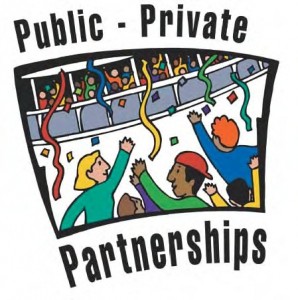 Owing to constrained investment, the education sector is unable to cope with growing market demand and global competition. Increased private investment is thus imperative to expand infrastructure and provide greater access to quality higher education in India. E&Y – FICCI report emphasises that PPPs could be an effective
Owing to constrained investment, the education sector is unable to cope with growing market demand and global competition. Increased private investment is thus imperative to expand infrastructure and provide greater access to quality higher education in India. E&Y – FICCI report emphasises that PPPs could be an effective
mechanism for attracting much needed private sector investment in the Indian Higher education system without diluting the regulatory oversight of the Government and other regulators
India’s enrollment figures in higher education emain abysmally low at a mere 11 compared to that of the US and Canada, where over 60 % of college-age students access higher education, highlighting that publicprivate partnerships are critical for wooing investment in India’s higher education system. This shortfall in the number of young who re eligible for higher education and the existing infrastructure presents India’s unique hallenge, in terms of the sheer scale of its population. India has over 400 universities and more than 20,000 colleges with an enrollment of 14 million students, yet it is grossly nadequate. A recently unveiled report by Ernst & Young and FICCI on various aspects of PPP, ighlights some pointers to possible solutions to challenges faced in by the nation’s ducation sector. Gaping resource gap The Government of India has allocated INR 850 billion or higher education in the 11th Five Year Plan. However, considering that the Planning Commission has identified a resource gap of INR 2.2 trillion, it is unlikely that the overnment alone can address infrastructure needs in the higher education sector in the near uture. While public expenditure on education has increased, the percentage share of Gross Domestic Product (GDP) spent on higher education has come down from 0.77% in 1991 o 0.7% in 2008. Moreover, there is an unequal outlay f resources for Higher Educational Institutions across the Indian states. Partnership models in education The report presents asic modes of partnerships that are possible between the government and the private sector. artnerships are established for varied reasons including construction, financing, design and aintenance of public infrastructure. PPP in social sectors such as health and education are ometimes referred to as Public- Social Private Partnership (PSPP). A number of PPP models can exist that range from simple management contracts to BOOT formats. These formats ary n the kind of benefits they yield. The report provides case studies of different types of PPP arrangements in education such as: Public-private financing of higher education Science/research parks University-owned companies The report underscores certain challenges that can be expected while applying the PPP model to education. For instance, the igh cost of such projects, relatively lower returns, and the current regulatory landscape akes it difficult to attract participants/ bidders for education projects. Another challenge is the lack f familiarity with the PPP procurement process. The report suggests measures that can be implemented to avoid these hurdles. The process of attracting bidders should be framed to inimise the bid costs with effective competition. Also, the university/college can be protected by way of monitoring the services offered by private players. Certain cases of successful PPP rojects in the education sector from other countries have been cited as examples, such as: Southbank Educational and Training Precinct Development involved the development of high standard facilities for the , Southbank Educational and Training Precinct Royal orthern College of Music in the UK which involved development of about 160 study rooms, staff and uest accommodation, car parking facility and a walkway. Industry-academia collaboration may include companies and institutes conducting joint R&D, industry internships, and corporates training and certifying students of affiliated institutes. Lastly, foreign university collaborations can offer access to world class faculty and international students, curriculum ased on global standards and sharing of culture. These may take the shape of exchange programmes, joint research projects or sharing of infrastructure facilities.
Regulatory ramework
for PPP An Higher Education Institute in India can be set up as a Trust, Society or as a Company registered under Section 25 of the Companies Act, 1956 (though the last is not ecognised by the HRD Ministry). Several regulatory bodies regulate the functioning of higher education in India. These comprise the University Grants Commission (UGC), All India ouncil for Technical Education (AICTE), Medical Council of India, etc. The higher education ystem suffers from several challenges that act as a hurdle in the growth ofthe PPP concept in ndia. These include the conditions imposed for setting up the educational institute as a not-for- rofit entity; xcessive regulations in the functioning of the HEIs and for the entry of oreign educational institutions into India. Despite these challenges, the PPP concept in the education sector needs to be explored. Since there are regulations with • respect to being a ot-for-profit entity, the infrastructure for educational institutions can be created through the PPP model. This could involve creation of a Trust by the Government/ HEIs to offer education ervices, which collaborates with a private player to avail infrastructure like uildings, hostels, laboratories, etc. This kind of a model would uphold the regulations imposed on educational institutions as well as leverage the partnership between the government and he private sector.
Findings
As a conclusion the report underscores the challenges that India’s igher education sector faces and calls for focused initiatives for remedial action, like targeted nterventions for increasing enrollment rates. It is also clear that the expansion of the higher ducation system in India would not be possible without sufficient levels of private sector funding, states the report, while adding that a clear gap exists in the availability of this rivate sector funding. It emphasises that there is a need to look at partnerships to create progress on this front in the near term,
University – Industry Interface
 Higher education serves several important functions in the society, the most important being production of knowledgeable individuals who will contribute to the society. However, many of the Indian universities do not fulfill this purpose. The demands of skilled and specialised manpower from the industry
Higher education serves several important functions in the society, the most important being production of knowledgeable individuals who will contribute to the society. However, many of the Indian universities do not fulfill this purpose. The demands of skilled and specialised manpower from the industry
are not being met as majority of graduates lack the necessary skill sets required by the industry. In recent years, a major concern of higher education planners and academics, the orld over, has been linking universities and other research institutions with industries. Universities can enhance the value of products in the form of knowledge; industry can ugment the university’s value in the form of funds. In India, way back in 1986, the National Policy on Education (NPE) highlighted the need for universityindustry interaction. However, despite efforts on the part of the Centre and State governments, universityindustry interaction has not shown a significant improvement till date. It still emains marginal and largely confined to a few institutions such as the IITs, IIMs, IIITs, NITs, etc. eed for university-industry interaction Universities are an important storehouse of p-to-date and advanced levels of knowledge in different fields. In a knowledge society, ndustries are the main users and beneficiaries of such knowledge. According to NASSCOM, ach year over 3 million graduates and postgraduates are added to the Indian workforce. owever, of these only
“Each year over 3 million graduates and post-graduates are added to the Indian workforce. However, of these only 25% of technical graduates and 10-15% of other graduates are considered employable by the rapidly growing IT and ITES (IT enabled
services) segments ”
25% of technical graduates and 10- 15% of other graduates are considered employable by the rapidly growing IT and ITES (IT enabled services) segments. Hence, what we have today is a rowing skills gap reflecting the slim availability of high-quality college education in India and the galloping pace of the country’s service-driven economy, which is growing faster than most of the countries in the world. A university-industry interaction is mutually benefitting as it provides industry an opportunity to grow its business by using the results of academic research. At the same time,university is in need of a partner that can take its discoveries/research findings to the arket place. The interaction can also earn additional resources of R&D, secure raining and final placements for students based on the respect earned from the relationship established with industry. The academic knowledge base can also help in reducing industrial cost, improving quality and competitive dimensions in products, reducing dependence on foreign know-how and expenditure on internal R&D. It can also assets the industry in upgrading the knowledge base of ndustry professionals through management development programmes. Possible areas of nteraction The university and industry can establish interface at varying levels with different egrees. This can range from simple consultations or visits to in-depth researches. Factors which hinder interaction In the backdrop of the above facts, there are some factors which hinder university-industry interaction. From university’s side, some of the inhibiting factors are: lack of nitiative amongst faculty towards applied research, lack of incentive to faculty, lack of experts and specialised technical infrastructure, bureaucratic hurdles in utilising consultancy funds, etc. Whereas from industry’s side, these factors include: insensitivity to or lack of wareness of the resource potential of the academia; a blind, herd-like obsession with expensive, ighprofile professional consultants; easy availability of foreign know-how; bad experience of earlier interactions with academia, etc. Further, absence of a full time/exclusive university- industry interaction cells in both the university and industry is also an important inhibiting factor.
How the interaction can be achieved?
For achieving a mutually beneficial relationship, there is a eed for change in the approach of both the university and industry. To promote university- ndustry interaction, following steps can be undertaken: Establishment of universityindustrypartnership/interaction cell. Organising workshops, conferences & symposia ith oint participation Participation of experts from industry in curriculum development. Professional consultancy by the faculty to industries. Visits of industry executives to the university nd deliver lectures on industrial practices, trends and experiences. Joint research rogrammes R&D laboratories sponsored by industries at the university. Scholarships/fellowships instituted by industries for students. Practical training of students in industries. Apart from ndustry associations, the universities should also establish linkages with government agencies which are engaged in industrial development activities.
Industry-Education Interface: Synergy for Success
The writing on the wall is clear. It is only through major strides of collaboration betweenthe private sector and government agencies that we can even attempt at improving theabysmal figures of number of college going students, which stands at a mere 10 % of thetotal population, actually being able access higher education institutions.The tremendous infrastructure for higher education, that the Indian government has createdover the decades, is proving inadequate for the millions of young men and women who couldbe in colleges and institutions. This is despite the fact that India has over 400 universitiesand more than 20,000 colleges with an enrollment of 14 million students.The added dimension that needs to be addressed simultaneously along with creating betterand professional infrastructure is the need for increasing employability of graduates emergingout of the HEI’s. This is vital for sustainability as 80 % of graduates stepping out with degreesdo not have any professional skills. Thus an industry-institution interface has to be evolvedin tandem with resource and infrastructure generation.In this issue we touch on these issues and capture new ideas and research that look aheadto an inevitable era of Public-Private Partnerships (PPP) in education. The recent E&YFICCIreport on various aspects of PPP in education highlights the resource gaps andpossible solutions to them. It also talks about various partnership models possible with the
private sector.An interview with Prof Kesav Nori, one of the pioneers of Tata’s computer based literacyprogramme, throws light on the literacy aspect in India and challenges associated withrunning the programme on a massive scale in a country like India with its diversities anduniqueness.In the urban slums of India, a silent revolution has been taking place in the form of privateeducation. Project Gyana Shakti is one such initiative seeking to improve learning outcomesin the schoolgoing children in the slums of Hyderabad through various technological andpedagogical interventions.All this only enforces the belief that a collective effort on the part of industry and governmentis inevitable, if our country is to gain a foothold in the global knowledge workforce.
IGNOU to Organise Workshop on Developing e-modules
The Indira Gandhi National Open University (IGNOU) is organising a two-day workshop on ‘Educational Resource Planning’ (EdRP) on January 7-8, 2012. The workshop is a collaborative project led by IIT-Kanpur, aimed at providing a common platform to the developers, University administrators, faculty members and ICT professionals for sharing their ideas on development and implementation of EdRP modules in the universities and educational institutions.
The EdRP mission project has been sanctioned by the National Mission on Education through ICT (NMEICT) of Ministry of Human Resource Development (MHRD) with the objective of developing an Open Source Educational Resource Planning system for universities and other educational institutions.
The workshop will be beneficial for institutions who wish to implement EdRP system and/or e-Learning systems. It will also be useful for students as it would provide them the opportunity to interact with experienced developers. It will elicit new functional requirements and also validate the modules being developed.
The collaborative project has Aligarh Muslim University (AMU), Amrita University, Dayalbagh Educational Institute, NIT-Hamirpur, IIT-Roorkee, Jamia Milia Islamia and Shri Mata Vaishno Devi University as its team members. Each partner institution is actively engaged in developing different modules for the EdRP using open source technologies and tools.
Goa Adopts new Strategy to Promote Midday Meal Scheme
According to a central government directive, there is a new mandate for schools in Goa to put the logo of the midday meal scheme on display on its buildings and print the logo on its letterheads, envelopes and registers. The idea is to create further awareness about the scheme that provides hot, cooked meals to school students and aims at eliminating malnutrition.
In Goa, the task of painting the midday meal logo in a prominent spot on the school building has been handed over to the Sarva Siksha Abhiyan (SSA). The SSA logo has already been painted prominently on primary school buildings across Goa and the midday meal logo will now be painted alongside.
ASER Report :: Drop-out Rate Declines, Access To Schooling Increases
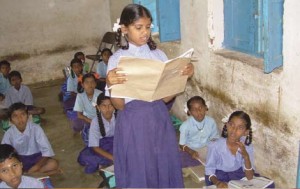 Drop-out Rate Declines, Access To Schooling Increases
Drop-out Rate Declines, Access To Schooling Increases
The number of girls and boys dropping out of their schools education has gone down, while more and more young people are accessing formal and informal schooling, says the Annual Status of Education Report (ASER) for the year 2007. The third definitive survey of status of school education across rural India, conducted by non-governmental organisation Pratham, indicates major progress over last two years in enrollment and availability of schools, teachers, toilets and water in most states. The findings of the survey also show a jump in mid-day meals, state-run free lunches to retain students in the schools. Another significant finding of the survey is increase in aanganwadi Integrated Child Development Scheme coverage, especially in the North India.
Drop-outs drop
Overall proportions of out of schoolchildren have dropped in the year 2007, since last year. This decline is visible in all age categories for both boys and girls.For boys and girls in seven to 10 year old age group, the percentage of out of school children in 2007 stands at below 3% for rural India. For girls in the age group 11 to 14, the percentage of out of school children has dropped from above 10 to 7.4 %. For Rajasthan and Bihar, the percentage of out of school children in the 6 to 14 age group was above 10% in 2006. This number has decreased to 6.5% in both the states in 2007. verall, enrolment in private schools has increased from 18.7% in 2006 to 19.3% in 2007. Therise in private school enrolment is noticeable in the older age group of 11 to 14 years. Private schools include government aided, unaided, recognised and unrecognised schools.
More young children accessing education
The survey also reported a substantial increase in the number of children attending pre-schools (anganwadi or balwadi). In 2006, 61.2% of kids threeyears of age were attending pre-schools as compared to 75.3% in 2007. For four year olds, there is an ncrease from 71.9 to 81.8%. Major increase in the proportion of children in pre-schools anganwadi or balwadi) has been reported in states like Punjab, Uttar Pradesh, Bihar, West engal, Orissa, Chhattisgarh and Kerala with anganwadi-balwadi enrollment showing a rise of ore than 10 percentage points between 2006 and 2007. Himachal Pradesh shows highest increase of 30 percentage points.
Learning levels improve
Overall reading levels showed improvement over 2006. Across the country, the proportion of children in first standard, who could not even recognise alphabets has dropped from 38.4 in 2006 to 31.9% in 2007. The proportion of children in standard one and two, who can recognise letters, read words or ore has gone up nationally from 73.3% in 2006 to 78.3% in 2007. Many states show mprovement in reading levels for children in Standard 1 and 2 and there is considerable ariation across states. In particular, Rajasthan, Arunachal, Manipur, Assam show an mprovement of more than 10 percentage points. Increases are also visible in Jammu and ashmir, Himachal Pradesh, Uttar Pradesh, Bihar, Jharkhand, Madhya Pradesh, Gujarat and Karnataka. National figures in 2007 show 58.3% children in Standard 5 can read tandard
Problem solving
All children were orally asked two problems. Both problems were about money and involved children subtracting numbers from INR 50. Children could give the answer orally or in written form.A small proportion of 6-8 year-olds could correctly answer the problems. In this ge group, 18% of school going children could answer questions as compared to 6% of on-school going children of the same age group. The ability to solve these problems is higher ith older children: 50% of 9-10 year old children can solve both problems and almost 74% hildren in the 11-14 age group can do the same. For older children (aged 11-14), of those who an correctly solve written numerical subtraction problems, about 66% can solve the word problems. Of children who can solve written division problems, close to 94% can solve the word problems.
Comprehension improves
ASER 2007 has explored the relationship between a hild’s ability to read and comprehend text by asking children oral questions based on texts f different levels. The ability to comprehend is closely linked with the ability to read. What is evealing is that when children are given a text that is more advanced than they are omfortable reading, a section of children is still able to tackle the text and understand it. For xample, among all 6-10 year olds, 23% are comfortably able to read words but not as yet able to read sentences fluently. Of these halting readers, about 11% can answer questions based on he Std 1 level text and about 6% on Std 2 level text. Note that the Standard 1 and 2 level texts are higher than what the child can read comfortably. Among the children reading a Std 1 level, 66% of children in the 6-10 age group can answer questions from a Std 1 level text. Even though these children cannot comfortably read a Std 2 level text, 23% can answer uestions based on a Std 2 level text. Similar patterns are visible among the older children 11-14 year) as well. Not only can a majority of children answer questions based on the level of extthat they are comfortably reading but significant percentage try to read a higher evel of text and understand it.
School infrastructure gets better
The number of schools with resh ater supply has risen from 67 to 72% for primary schools and 73 to 77% in middle chools. Similar improvements are also seen in terms of toilets. However, there are still a little ver 25% schools that either do not have water or if they do have water it is not usable. The corresponding figure for toilets is 40%. In about 92.6% of the schools visited on a random ay in October/ November 2007, midday meal was seen being prepared or served. This figure s much higher than the comparable figure in 2005, which stood at 71.1%. Well over 75% of all teachers had received TLM grants for 2006 and over half had received them for 007. Similarly, for school maintenance grants, over 80% of schools had received their grants n 2006 and over 60% in 2007. It is likely that the remainder of grants may be sent to chools and teachers by the end of the 2007-08 financial year. In India, due to low nrollments in small habitations, children in about half of all classes in visited schools, duringthe ASER survey, sat with students belonging to another standard. This number anges rom close to 70% in states like Bihar and Jharkhand to as low as 3% in Kerala. The indings from ASER 2007 shows that rural India’s schools are well on course towards the goal of niversalising elementary education. It also highlights non-formal schooling providing ital support for the first generationof rural learners. The decline in drop-out rates and increase in eacher attendance are a promising signs of emerging quality education in rural schools
NUEPA Report :: India’s 87% Schools Without Computers
India’s 87% Schools Without Computers
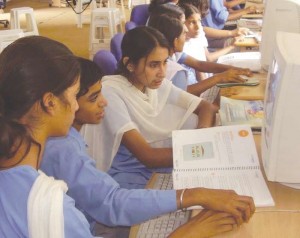
The report highlights varying regional access to school computers. Barring Delhi, Maharashtra, southern states, Gujarat and Madhya Pradesh, access to such facilities remains virtually nonexistent to most students in the country…
Even as India excels towards the target of elementary education for all, its ICT capabilities, so far as school education is concerned, remains severely challenged by low availability of computers in the schools.
However, according to a report ‘Strengthening Education Management Information System in India’ , published by the HRD Ministry and the National University of Educational Planning and Administration (NUEPA), the growth in the number of computers in schools
since 2004 is truly remarkable. During the period 2003-04 to 2006-07, the number of schools with computers increased substantially, both in percentage and absolute terms. Since 2004, when just 72,000-odd schools (7.68%) had computers, which has now risen to 1,67,000-plus schools (13.43%) for 2007. The number of schools having provided computers during the year 2005-06 was 120.6 thousand (10.73%), during 2004-05, 93 thousand (8.99%) and in 2003-04, 72 thousand (7.68%). Currently, more than 160,000 primary schools in the country had computers in place.
Rural and urban variations
The percentage of Primary schools having computers is much lower at 6.51% than that of the other school types. It is high at 18.20% in urban areas and low at 5.34% in rural areas. As many as 50,747 Primary schools in 2006-07 are provided with computers of which 75% is in rural areas and only 25% in urban areas. The percentage of government schools with computer has shown improvement over the previous year (6.57% in 2005-06 to 8.57% in 2006- 07). Compared to 8.57% government schools having computers, the percentage in case of schools under private managements is much higher at 34.43%. This is also true for all other types of schools. About 62% integrated Higher secondary and 59% upper schools under the private managements have computers.
Regional disparities
The report also highlights varying regional access to school computers. Barring Delhi, Maharashtra, southern states, Gujarat and Madhya Pradesh, access to such facilities remains virtually non-existent to most students in the country. Maharashtra has the highest number
of schools – 28,882, which constitutes 33.42% of its total schools – that have computers in schools, followed by 19,154 schools in Andhra Pradesh, 16,064 schools in Madhya Pradesh, 13,336 schools in Rajasthan, 11,603 schools in Tamil Nadu. In terms of percentage of schools which have computers in each state, Delhi stands first (68.85), followed by Kerala (60.9), Maharashtra (33.42), Gujarat (24.03) and Tamil Nadu (22.13). Except for Delhi, Chandigarh, Kerala, Gujarat, Lakshadweep, Maharashtra, Orissa, Puducherry, Sikkim and Tamil Nadu, the percentage of computer penetration in primary schools is below double digit in the rest of India. The lowest numbers, 12 Schools, of computer facility is in the Dadra & Nagar Haveli, followed 15 schools in Daman & Diu, 22 schools in Lakshadweep, and 119 schools in Andaman & Nicobar Islands. In Bihar too, the percentage of schools with computers was found to be low at 2.62 or 1,436 schools. However, the spread of computer education has been limited to just 6.51% of all primary schools in the country. And except for Delhi, Chandigarh, Kerala, Gujarat, Lakshadweep, Maharashtra, Orissa, Puducherry, Sikkim and Tamil Nadu, the percentage of computer penetration in primary schools is below double digit in the rest of India. The NUPEA survey highlights the major strides India has taken in terms of making the very basic tool for ICT delivery available to schools. But it also underscores the huge number of schools that are without it and hence only on the fringes of the access to online and audio-video content, which is being looked at with such enthusiasm for addressing the issue of distance and infrastructure



